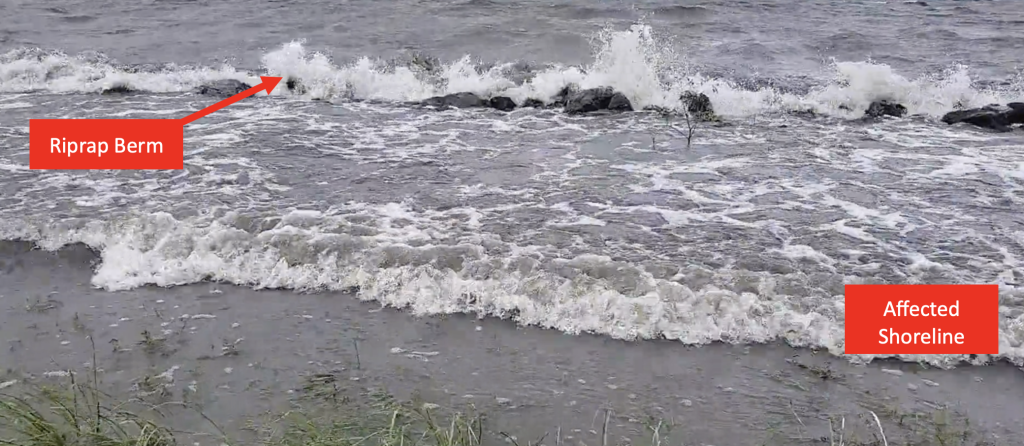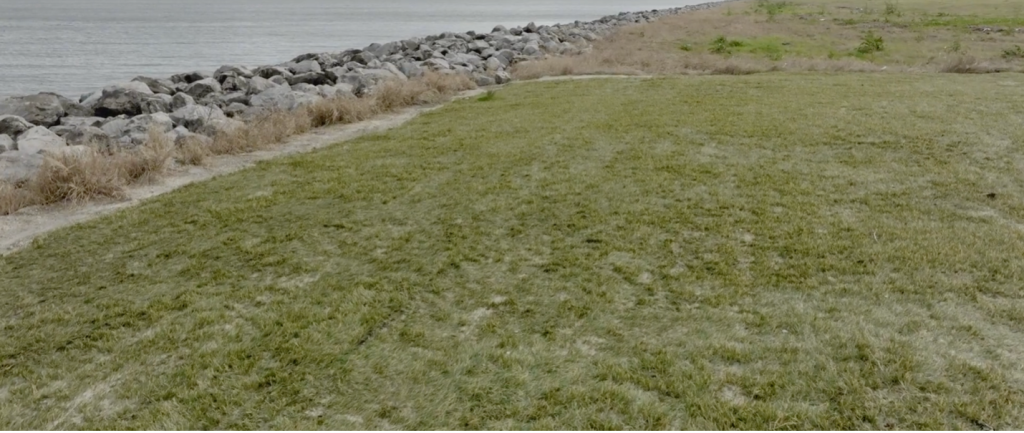HydroTurf® proves successful for shoreline erosion protection in Louisiana’s East Jefferson Levee District Pilot Study.
In an effort to protect the soils surrounding the shorelines of the New Orleans levee system during severe weather events, the US Army Corps of Engineers (USACE) extended the wave berm in the East Jefferson Levee District (EJLD) along Lake Pontchartrain, which was completed in 2012. This foreshore component is part of the overall Hurricane and Storm Damage Risk Reduction System (HSDRRS) that protects Jefferson Parish. It was created by constructing a rip-rap berm in the lake and filling in the area from the previous shoreline to the rip-rap berm. This critical element of the HSDRRS reduces potential high energy wave impact on the earthen levees. Since the completion of its construction in 2012, the rock berm has experienced significant reduction in its elevation and the soils between the berm and the levee are eroding (pictured below).

To save these soils from erosion, the Flood Protection Authority conducted a pilot study project to study several different methods for achieving a long-term solution to protecting these soils. Tasked with finding an aesthetically pleasing, economical solution that would last for many years, the Flood Protection Authority installed three test sections along the levee.
We have 190 miles of levee and floodwall to protect, so we have to spend our money wisely. We want to put a product out there that’s going to last for many, many years and be robust enough to withstand the energy that we have learned this lake produces during high water events.
CHRISTOPHER HUMPHREYS, P.E.
FLOOD PROTECTION AUTHORITY – EAST.
DIRECTOR OF ENGINEERING
The pilot study tested multiple different product types: vegetative solutions that included a spartina grass and a vetiver grass; articulated concrete block; turf reinforcement matting; and HydroTurf®. HydroTurf is an impermeable cementitious and artificial turf product that offers the aesthetics of natural grass while maintaining resistance and protection from high wave energy. It uses an impermeable geomembrane protected by engineered turf which is infilled with HydroBinder®, resulting in a fiber reinforced high-strength concrete matrix.

Now in place for three tropical storm seasons, the pilot study results are clear. At this point in the pilot study, all of the products have experienced failures. All of them, except for the HydroTurf, were inadequate for the energy that we’ve experienced.
DONALD JEROLLEMAN JR., MSC, P.E.
FLOOD PROTECTION AUTHORITY – EAST.HydroTurf® Advanced Revetment System
SENIOR PROJECT MANAGER

VARIOUS TEST PLOTS POST STORM



HYDROTURF® TEST PLOT POST STORM

We believe that the HydroTurf performed very well. It met the criteria we were looking for with a reasonable initial cost and certainly performed very well in a high energy environment
.DONALD JEROLLEMAN JR., MSC, P.E.
SENIOR PROJECT MANAGER
FLOOD PROTECTION AUTHORITY – EAST.
Since the HydroTurf system has been in place, New Orleans and the surrounding area has experienced multiple weather events, including Hurricane Ida, Hurricane Zeta, Tropical Storm Cristobal, Tropical Storm Beta and several other severe storm events. All of these events caused wave action over the riprap berm and into the levee shoreline area contributing to the ongoing erosion. The following figures detail the weather conditions experienced at or near the pilot site during July 1, 2020 through February 23, 2022. A few notable highlights during that time include max wind gust speeds of 90 mph and a 24-hour max rainfall reaching 6.47 inches. HydroTurf experienced no erosion or damage.


Additional wind data and tidal information were collected from the New Canal Station, LA, NOAA tidal gauge. During Hurricane Ida, the pilot HydroTurf test plot would have been completely submerged based on nearby NOAA tidal elevations. In addition, wave action would have been acting upon the test plot during Hurricane Ida and during all or most of the remaining “Top Ten” events.

The outcome of this pilot study with the Flood Protection Authority will help guide decisions in years to come on how to best protect the New Orleans soils and levees needed to reduce risk from storm surge to the surrounding community.



